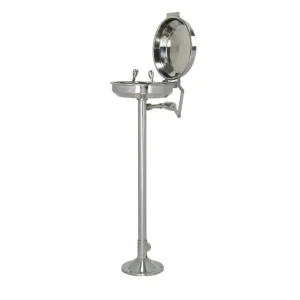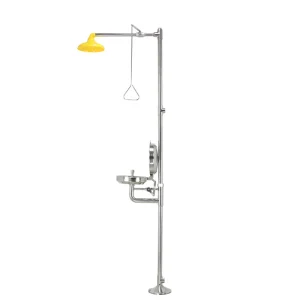Emergency shower and eyewash stations are critical safety devices designed to mitigate chemical exposure risks in industrial, laboratory, and medical settings. This article explores their core features, practical applications, safety precautions, and 2025+ regulatory updates to ensure compliance and optimal protection.
1. Key Features of Emergency Shower and Eyewash Stations
- Dual-Function Design:
- Shower System: Delivers a high-flow (≥76 L/min) water spray for full-body decontamination.
- Eyewash System: Provides a gentle, adjustable flow (9–16 L/min) for eye and facial irrigation.
- Material Durability:
- Constructed from 304 stainless steel or high-performance anti-corrosion materials (e.g., for hydrochloric acid or sulfuric acid environments).
- Temperature Control:
- Equipped with electric tracing or auto-drain anti-freeze systems to prevent freezing in cold climates (critical for outdoor or refrigerated facilities).
- Accessibility Compliance:
- Positioned within 10–15 meters (33–49 feet) of hazard zones, with a 10-second reach requirement per ANSI Z358.1.
- Shower heads mounted at 2080–2440 mm, eyewash nozzles at 838–1143 mm above ground level.
2. Usage Scenarios
- Chemical Splashes:
- Full-body exposure: Activate the shower system for ≥15 minutes while removing contaminated clothing.
- Eye/face exposure: Use the eyewash system for ≥15 minutes, keeping eyelids open and rotating eyes.
- Thermal Burns:
- For clothing fires, douse with the shower system before removing garments.
- Industry Applications:
- Chemical plants, petroleum refineries, electronics manufacturing, and medical labs (e.g., blood dialysis centers, pathology labs).
3. Critical Safety Precautions
- Immediate Action:
- Do not delay—activate the device within 10 seconds of exposure.
- Remove contaminated clothing while under the shower to prevent prolonged skin contact.
- Water Quality:
- Ensure water meets GB 5749 (China’s drinking water standard) or equivalent to avoid secondary contamination.
- Temperature Range:
- Maintain water at 16–38°C (60–100°F) to prevent hypothermia or chemical reaction acceleration.
- Post-Use Protocol:
- Seek medical attention immediately, even after initial rinsing. These devices are not substitutes for professional treatment.
- Maintenance:
- Weekly checks for water flow, valve functionality, and debris in nozzles.
- Monthly anti-freeze system tests in cold regions.
4. Post-2025 Regulatory Updates
4.1 Enhanced Anti-Corrosion Standards
- New ANSI Z358.1-2025 Amendment:
- Mandates high-performance anti-corrosion coatings for devices exposed to hydrofluoric acid, concentrated sulfuric acid (>50%), and chloride-rich environments.
- Requires third-party certification for materials used in extreme-corrosion zones.
4.2 Smart Monitoring Integration
- IoT-Enabled Devices:
- Some 2025+ models feature real-time water flow sensors and freeze-risk alerts via mobile apps.
- Automated maintenance logs to streamline compliance reporting.
4.3 Stricter Temperature Controls
- GB/T 38144.1-2025 (China):
- Requires dual-temperature sensors (one at the inlet, one at the nozzle) to ensure consistent 16–38°C output.
- Prohibits manual overrides in freeze-prone areas.
4.4 Accessibility for Disabled Users
- Ergonomic Redesigns:
- Lower eyewash nozzle heights (≤900 mm) for wheelchair access.
- Voice-activated controls for visually impaired users.






